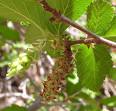Ironwood Tree Information
Images of Ironwood:






Ironwood grows in the following 4 states and provinces:
Arizona, New Mexico, Texas, UtahInformation about Ironwood:
The Ostrya Knowltonii is commonly known as the Ironwood, Knowlton Hophornbeam, Western Hophornbeam, Wolf Hophornbeam as well as Woolly Hophornbeam.
The currently accepted scientific name for Knowlton hophornbeam is Ostrya knowltonii Coville . There are no recognized subspecies, varieties, or forms.Knowlton hophornbeam is found in southeastern Utah, northern Arizona, southeastern New Mexico (in the Guadalupe and Sacramento mountains in Eddy County), and northern Trans-Pecos Texas. It is not a common tree and its occurrence is sporadic even in these areas .Knowlton hophornbeam is commonly found in oak (Quercus spp.) woodlands, pinyon (Pinus spp.)-juniper (Juniperus spp.) woodlands, and lower ponderosa pine (Pinus ponderosa) forest zones . In Texas it is a component of the gray oak (Quercus grisea)-true pinyon (Pinus edulis)-alligator juniper (Juniperus deppeana) association at 5,000 to 7,000 feet (1,524-2,133 m) and the ponderosa pine-Douglas fir (Pseudotsuga menziesii) association at 6,000 to 7,500 feet (1,828-2,286 m). In Texas it is also associated with Texas madrone (Arbutus texana), southwestern white pine (Pinus strobiformis), chinkapin oak (Q. muehlenbergii), and bigtooth maple (Acer grandidentatum) . In deciduous canyon woodlands of Guadalupe Mountains National Park, Texas, Knowlton hophornbeam will increasingly replace wavyleaf oak (Q. undulata), alligator juniper, Riogrande cottonwood (Populus deltoides ssp. wislizenii) and little walnut (Juglans microcarpa) as the moisture gradient goes from xeric to mesic. Knowlton hophornbeam is replaced by bigtooth maple and chinkapin oak, especially on upper terraces, around springs and in canyonheads . Some of the information provided here is attributed to:Tesky, Julie L. 1994. Ostrya knowltonii. In: Fire Effects Information System, [Online]. U.S. Department of Agriculture, Forest Service, Rocky Mountain Research Station, Fire Sciences Laboratory (Producer). , available at the USDA Fire Effects Information System (FEIS) website